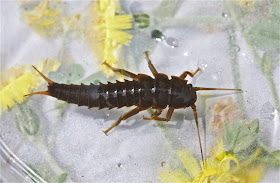Thursday, June 2, 2011
Baby Giants: The Next Generation Appears
Today I returned to the wonderful tributary of the Moormans to which I first came on March 4th. If you look back at the entry I posted that day, you'll see that I found a lot of Giant stoneflies (Pteronarcyidae) -- various sizes, but many quite big, maybe 1 1/2" long. Here's one of the pictures I took that day.
No big Giants today -- but a whole lot of "babies". In one leaf pack alone, I found 10-12 nymphs! Size? I'd say 1/4" long. I did find a few that were bigger than that, say, 3/4" long, and I can show you a photo of one of those "toddlers" or "teens".
I was lucky to get a few pictures of the little ones crawling around on this nymph: these will give you a good sense of just how small the little ones were.
Are the small giants that I found today the offspring of the large Giants I saw in the winter? Possibly, not necessarily. The eggs for this summer's "babies" might have been laid in the spring of 2010. Giant stoneflies are "semi-voltine," i.e. they take two years to mature (see the entry posted on 1/13). So I would not be surprised to learn that this summer's "babies" have been tucked away in the substrate until now -- but I don't know that for sure.
These were not the only small stoneflies that I saw today. I also picked up two tiny Roach-like stoneflies (Peltoperlidae). Here's a good shot of one of the two.
I'm really pleased with this photo since this nymph was between 1/16" -- 1/8" long! I got a shot of it next to an Eccoptura Common stonefly, and this really indicates just how small this little guy was.
Now, these baby Peltos probably are the offspring of the Peltoperlids that hatched during the spring. Peltoperlids have a one year life cycle (they're "univoltine"), so that pretty much settles the issue. And remember that I found a Peltoperlid at the Rapidan River on May 5th that was not far from hatching.
I found very few mayflies today -- but then, there's a reason why they're called "may" flies: they hatch and fly off in May! There were still some Epeorus flatheads around, and one or two spiny crawlers --even a very mature (black wing pads) pronggilled mayfly -- but that was all. There were a few other stoneflies: all Perlodids. Most of these were Isoperla holochloras; but I did find another genus Remenus.
I expected to find some Limnephilids -- Northern case-maker caddisflies -- but nothing showed up. The sole caddis I found was a common netspinner, genus Diplectrona.










What an incredible look into the fascinating world of aquatic insects! It’s amazing to see the next generation of these baby giants and learn about their unique life cycle. Seaside Serenity: The Top 5 One-Piece Swimwear and Cover-Up Combinations
ReplyDeleteAs someone who loves exploring nature and finding great deals on gear for outdoor adventures, I often rely on Dazzle in Red: 7 Stunning Dresses You Need in Your Closet to make my hobbies more affordable.
ReplyDeleteScience
ReplyDelete